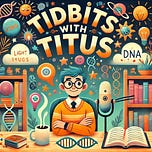What Are Fossils?
Have you ever wondered what fossils are? Fossils are like nature’s time capsules. They are the remains or traces of plants and animals that lived long, long ago. Some fossils are bones, some are shells, and some are even footprints! Let’s dig deep to discover more about fossils and why they’re so amazing.
Hello my friends!
For a quick note, welcome to Tidbits with Titus, a podcast and newsletter where we tackle the big, curious questions kids ask every day in fun, bite-sized ways! I’m Alexander Titus, but I go by Titus. I’m a scientist, adventurer, and a huge fan of making science, technology, and life accessible to all ages. From “How does electricity work?” to “What are taxes?” and even “Why is the sky blue?” I’m here to dive into these wonder-filled questions with engaging stories and simple explanations that spark curiosity and make learning a joy. This effort is all about creating a space where families can learn together, discover the magic of the every day, and find thoughtful ways to explore the world’s big mysteries. Let’s make curiosity a family tradition—one tidbit at a time!
Just so you know, these podcast episodes are all AI-generated using Google’s really cool NotebookLM technology. That means there are some errors in how words are said, but that is part of the fun!
If your little ones have questions that you want help answering, shoot me an email at questions@tidbitswithtitus.com and I’ll see what I can do!
You can subscribe to the newsletter that has this information as well at tidbitswithtitus.com.
Also please share with anyone you think would be interested. The more the merrier!
Cheers,
-Titus
What Are Fossils Made Of?
Fossils can be made of different things:
Bones and Teeth: These are the hard parts of animals that can turn into fossils after many years.
Shells: Creatures like clams and snails leave behind their hard shells, which can become fossils.
Imprints: Sometimes, a leaf or a footprint gets pressed into mud, and over time, it hardens into a fossil.
Amber: This is hardened tree sap that can trap tiny creatures like insects and preserve them perfectly.
How Are Fossils Made?
Making a fossil takes a very long time—sometimes millions of years! Here’s how it happens:
An Animal or Plant Dies: Imagine a dinosaur that dies near a river.
It Gets Buried: Mud, sand, or dirt covers the remains, protecting them from weather and hungry animals.
Minerals Replace the Bones: Over time, water with minerals seeps into the bones, turning them into rock.
The Fossil Is Found: After millions of years, scientists, called paleontologists, might dig up the fossil to study it.
Types of Fossils
Not all fossils look the same. Here are some types:
Body Fossils: These are the actual remains of an organism, like bones or teeth.
Trace Fossils: These show evidence of how an animal lived, like footprints or burrows.
Mold Fossils: These are hollow imprints of an organism.
Cast Fossils: These form when a mold fills with minerals and hardens into the shape of the organism.
Why Are Fossils Important?
Fossils help us learn about life on Earth a long time ago. They tell us:
What kinds of animals and plants lived in the past.
How animals and plants have changed over time.
What the Earth’s climate was like millions of years ago.
How continents and oceans have shifted and changed.
Fun Facts About Fossils
Dinosaur Fossils: Some of the biggest fossils are from dinosaurs, like the mighty Tyrannosaurus rex!
Oldest Fossils: The oldest fossils on Earth are more than 3 billion years old and come from tiny bacteria.
Fossilized Poop: Yes, even poop can become a fossil! Scientists call it coprolite, and it helps them learn what animals ate.
Petrified Wood: Trees can turn into rock over time, creating a special kind of fossil called petrified wood.
Amber Fossils: Insects trapped in amber look like they’re frozen in time.
Where Can You Find Fossils?
Fossils can be found all over the world! Some great places to look include:
Rocks: Fossils are often hidden inside layers of rock.
Beaches: Fossilized shells and bones sometimes wash up on the shore.
Quarries: These are places where people dig up rocks and sometimes find fossils.
Museums: You can see amazing fossils on display at museums, like dinosaur skeletons!
What Do Paleontologists Do?
Paleontologists are scientists who study fossils. They use tools like brushes and chisels to carefully uncover fossils from rocks. Once they find a fossil, they study it to learn about the past. Paleontologists have discovered incredible things, like how dinosaurs lived and what the Earth looked like millions of years ago.
How Big Are Fossils?
Fossils come in all sizes:
Tiny Fossils: Some fossils are as small as a grain of sand, like tiny shells or pollen.
Huge Fossils: Others, like dinosaur bones, can be as long as a bus!
Can You Make a Fossil at Home?
While it takes millions of years to make a real fossil, you can create your own pretend fossil at home! Here’s how:
Materials You Need: Clay, a small object like a leaf or shell, and some paint.
Press the Object: Push the leaf or shell into the clay to make an imprint.
Let It Dry: Wait for the clay to harden.
Paint It: Use paint to make your fossil look like rock.
Now you have your own “fossil” to show your friends!
Fossils and Dinosaurs
Dinosaurs are some of the most famous creatures we know about because of fossils. Scientists have found dinosaur bones, eggs, and even skin impressions. By putting these pieces together, they can figure out how dinosaurs looked, what they ate, and how they moved. Isn’t that cool?
Fossil Treasures
Some fossils are extra special and tell amazing stories. Here are a few examples:
The Archaeopteryx: This fossil shows a dinosaur with feathers, proving that birds are related to dinosaurs.
The Ice Age Mammoth: Fossils of these giant, furry elephants have been found frozen in ice!
Fish in Action: Fossils have even captured fish in the middle of eating other fish.
Fossils and Time
Fossils can be millions or even billions of years old. They help scientists create a timeline of Earth’s history, called the geological timescale. This timeline shows how life on Earth has changed over time, from tiny sea creatures to giant dinosaurs and finally to humans.
How Are Fossils Protected?
Fossils are precious, so people work hard to protect them. Scientists and governments make rules to keep fossils safe so they can be studied and enjoyed by everyone. In some places, it’s illegal to take fossils without permission.
How Can You Learn More About Fossils?
If you want to learn more about fossils, here are some ideas:
Visit a Museum: Many museums have fossil exhibits where you can see dinosaur skeletons and other amazing finds.
Read Books: There are lots of books about fossils and dinosaurs for kids.
Go on a Fossil Hunt: Some places let you dig for fossils with a guide.
Watch Videos: Look for educational videos about fossils and paleontology online.
Why Are Fossils So Cool?
Fossils are like a secret code from the past, waiting to be cracked. They help us understand what the world was like millions of years ago and how life has changed over time. So the next time you see a fossil, remember that it’s a tiny piece of Earth’s incredible history!














Share this post